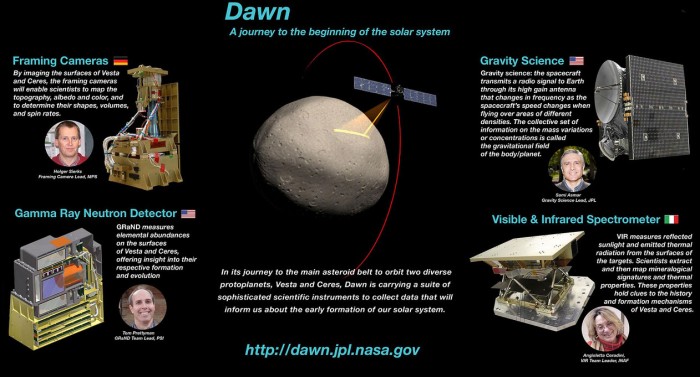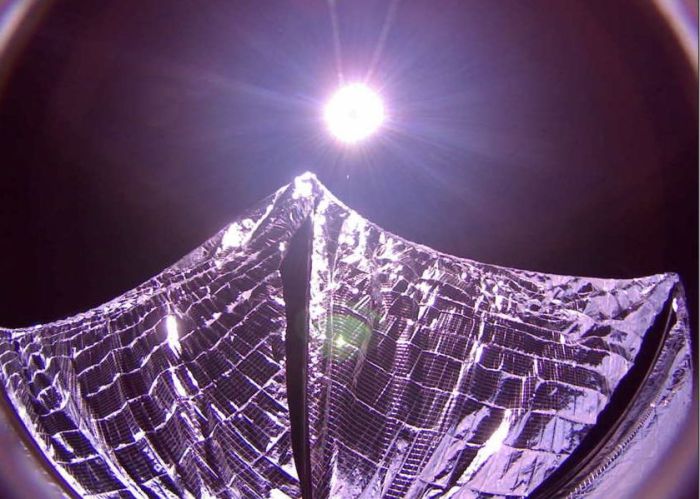
The joint ESA / NASA Dawn mission to study two of the solar system’s three “protoplanets” located in the asteroid belt between the orbits of Mars and Jupiter, continues to intrigue scientists.
Launched in September 2007, and costing US $446 million, Dawn is part of a broader effort to better understand the origins of the solar system and how the planets actually formed; all of which might give us greater understanding of how life arose here on Earth.
The mission has been relatively low-key when compared to the likes of NASA’s MSL rover on Mars or Europe’s Rosetta mission to comet 67P/C-G and NASA’s other mission to tiny world. New Horizons, but the Dawn spacecraft and mission are quite remarkable. The little spacecraft is use ion propulsion to enter orbit around a planetary body and is the first to orbit a dwarf planet and, since its arrival in orbit around Ceres, the first spacecraft from Earth to visit that tiny dwarf planet and the first mission to orbit two separate extraterrestrial bodies.
Dawn arrived at Ceres in March 2015, after a 2.5 year transit flight from Vesta, its first destination, where it spent 14 months in orbit following its arrival there in July 2011. Because of their relative size – Ceres accounts for around one-third of the total mass of the asteroid belt – both of these airless, rocky bodies are regarded as dwarf planets, rather than “simple” asteroids. However, they are both very different bodies to one another.

With a diameter of 525 kilometres (326 miles), Vesta is the smaller of these two worldlets, and is technically regarded as water-poor achondritic asteroid comprising a tenth of the mass of the asteroid belt. Its density is lower than the four inner planets of the solar system but higher than most of the moons and asteroids.

Ceres, with a diameter of 950 kilometres (590 miles), is just 2.5 times smaller than distant Pluto, the target of the New Horizons mission. Its spectral characteristics suggest a composition similar to that of a water-rich carbonaceous chondrite. Like most of the material within the asteroid belt, it formed very early in the history of the Solar System, thereby retaining a record of events and processes from the time of the formation of the terrestrial planets.
Since arriving in orbit around Ceres, Dawn has returned some intriguing images of apparent bright spots within a crater. These were first seen in late 2014, as Dawn made its initial approach to Ceres, and have since been imaged on numerous occasions, and have been tracked as Ceres rotates, eliminating them as being imaging artefacts. Studies of much lower resolution images of Ceres taken by the Hubble Space Telescope also reveal these bright spots – although such is the distance of Ceres from Hubble that where they do appear in HST pictures, they are little more than a single bright blob.
The thinking on the bright areas are that they are water ice or possibly frozen salt deposits – although they could be something more exotic. Over the last two months, Dawn has been able to image the bright areas, which lie in a crater some 92 kilometres (57 miles) across, situation some 19 degrees above Ceres’ equator. On June 6th, 2015, Dawn returned the best images yet of the bright spots, and these have been added to an animation made up of multiple images of Ceres, showing it rotating about its axis.
At the end of June, Dawn will commence a series of manoeuvres which will gently lower its orbit over the period of 6 weeks, allowing it to get much more detailed images of the surface of Ceres and these strange spots. As the images will also be captured from multiple angles, scientists hope they’ll provide sufficient information for the composition of the bright spots to be understood.
NASA’s “Flying Saucer” Flies Again
In June 2014 I wrote about NASA’s Low-Density Supersonic Decelerator (LDSD) “flying saucer”, a test rig for investigating new technologies which may help to deliver increasingly heavy payloads to the surface of Mars – a vital requirement ahead of possible human missions in the 2030s.
LDSD is intended to test two systems: an inflatable decelerator, which would form a part of a payload’s aeroshell, and a new parachute designed to operate at supersonic speeds. The lightweight decelerator is designed to inflate after entry into the Martian atmosphere, increasing a payload surface area, and therefore the drag it creates through the atmosphere, helping to slow it down faster. The parachute is designed to deploy at much higher velocities than would normally be expected, again allowing the vehicle to slow to a point where other landing systems could be used.

Both systems were first tested at Mach speeds in the Earth’s atmosphere in August 2014. at the start of June 2015, were once again tested, which a “flying saucer” test vehicle was carried to an altitude of 120,000 feet by balloon, prior to detaching and using a rocket motor to boost it to 180,000 feet and a speed of Mach 4. The inflatable decelerator was then successful deployed to initially slow the craft. However the 30 metre (100 ft) diameter supersonic parachute, the largest of its kind made, shredded on deployment, although the 5 metre (16ft) diameter “flying saucer” did successfully splash down near Hawaii and was successfully recovered.
If both the inflatable decelerator and the parachute are proven, the hope is that together, they will allow payloads of up to 30 tonnes to be safely delivered to the surface of Mars.
LightSail Success
After considerable tribulation, as recorded in the last couple of Space Sunday reports on this blog, the Planetary Society’s LightSail-1 mission successfully deployed its solar sail in orbit.
Solar Sails are a long-held concept for capturing the solar wind – the outward flow of particles from the sun – and using them as a means of propulsion. It has been a staple of science-fiction for decades, and could offer a relatively cheap means of operating space vehicles across interplanetary space without the need to burden them with heavy payloads of fuel and engine systems. The force experted by the Sun in this way is not great, but it is cumulative; provide a big enough area of sail, and quite reasonable velocities could be achieved over time. It’s even been theorised that space-based lasers could be employed to provided focused beams of energy which could propel craft using solar sails from point to point around the solar system.

The LightSail project is an attempt to prove the concept through practical means, and involved two planned lights of small scale satellites, each just 30x10x10 centimetres (12x4x4 inches), of which LightSail-1 is the first. Its sole aim was to test the mechanism required to deploy a 32 square metre (344 square feet) Mylar sail just 4.5 microns thick.
Launched at the end of May, the satellite had been struck by a software glitch (recovered from when a fast-moving charged particle struck its electronic components in just the right way to make it reboot itself), which put a halt to operations until the reboot occurred. Then the craft was forced to put itself in a “safe” mode, while the solar panels (which could not be deployed as a result of the initial software glitch) recharged the overworked batteries.
However, on Sunday, June 7th, the tiny satellite was finally able to resume normal operations, and finally and successfully deployed its solar sail, taking a selfie to prove it had.

The craft didn’t undertake any solar sailing per se. That will be the aim of the LightSail-2 mission, scheduled for 2016.
It’s all a Matter of Size
Ever wondered about just how big things really are in the galaxy? To us, the world seems huge; yet by the standards of the solar system, it’s really not that big; especially when compared to the Sun.
But the Sun itself really isn’t that remarkable; it’s simply an average-sized star in its middle years. There are stars both older and younger that not only make it look rather puny, size-wise, they actually reduce it to something of the scale of the Earth when it gets compared to the Sun.
If this all sounds a tad hard to grasp, I came across this wonderful video by “morn 1415” which puts matter of size into some perspective, comparing the planets of the solar system with the Sun, and the Sun itself with several other candidates found in the Galaxy. The latter include one of the most luminous stars discovered – the Pistol Star. Although 25,000 light years away, would be bright enough to appear as a 4th magnitude star in our night sky, but for being masked by interstellar dust. also included is the truly gigantic VY Canis Majoris, one of the biggest stars in the galaxy, around 3,900 light-years from Earth, and a 7th magnitude star (and one of the brightest in its classification). However, I’ll let the video tell you how mind-bogglingly big VY Canis Major is!
(video with alternative soundtrack here.)
Image credits as indicated; video courtesy of Space.com and morn 1415.